

25th European congress of psychiatry / European Psychiatry 41S (2017) S365–S404
S401
Disclosure of interest
The authors have not supplied their decla-
ration of competing interest.
http://dx.doi.org/10.1016/j.eurpsy.2017.02.468EW0855
Unexpected variations in official UK
statistics related to rates of suicide
and those of undetermined intent:
An exploration of causes
D. O’Reilly
1 ,∗
, M. Rosato
21
Queen’s University Belfast, Centre for Public Health, Belfast, United
Kingdom
2
Ulster University, Bamford Centre for Mental Health and
Well-Being, Belfast, United Kingdom
∗
Corresponding author.
Background
Official rates of suicide are perhaps the most impor-
tant and enduring measures of population mental health. They
are however prone to variations in reporting usually relating to
deaths where the intention was uncertain, though most official
statistics circumvent this by including ‘events of undetermined
intent’ (ICD10 Y10-34 and Y87.2) along with ‘intentional self-harm’
in their official statistics. It is however unclear how successful
this strategy has been and whether significant sources of bias still
persist.
Aim
To systematically examine the dramatic change in rates of
death from suicide (and undetermined intent) in Northern Ire-
land, that coincided with a major overhaul and reorganisation
of the Coroners Service in 2005/6, to understand the extent to
which the initial investigation by the coroners’ office, legal process-
ing, registration and coding practices can influence official suicide
statistics.
Methods
In the space of one year, Northern Ireland went from
having a standardised rate of suicide (incl undetermined intent) of
12.6/100,000 in 2004 to 26.6/100,000 in 2006 (a 111% increase) and
indoing sowent fromhaving consistently the lowest to consistently
the highest registered rate of suicide in the UK.
Results
Initial analyses rules out changes in the police service,
pathology service or registration coding practices as causative and
suggest that the introduction of a coroner’s liaison officer (with a
formal data gathering role) was the most likely factor. The centrali-
sation of the coroners’ service also reduced variations according to
age, sex, geography and coding.
Conclusions
The process underpinning official statistics need to
be routinely scrutinised.
Disclosure of interest
The authors have not supplied their decla-
ration of competing interest.
http://dx.doi.org/10.1016/j.eurpsy.2017.02.469EW0856
Alcoholic psychoses and suicide
trends in Russia, Belarus and Ukraine
Y. Razvodovsky
Grodno State Medical University, Pathological Physiology, Grodno,
Belarus
Introduction
The dramatic fluctuations in suicidemortality in the
countries of the former Soviet Union (fSU) over the past decades
have been widely discussed in the scientific literature and are
still relatively unexplored. Accumulated evidence suggests that
the mixture of cultural acceptance of heavy drinking, high rate of
distilled spirits consumption, and binge drinking pattern is major
contributor to the suicide mortality burden in fSU countries.
Aims
The present study aims to analyze whether binge drink-
ing is able to explain the dramatic fluctuations in suicide mortality
in Russia, Belarus and Ukraine from the late Soviet to post-Soviet
period.
Method
Trends in alcoholic psychoses incidence and suicide rates
from 1980 to 2015 in Russia Belarus and Ukraine were analyzed
employing a Spearman’s rank-order correlation9 analysis.
Results
The estimates based on the Soviet data suggest a strong
positive association between alcoholic psychoses and suicide rates
in Russia, Belarus and Ukraine. This positive relationship was less
evident in the post-Soviet period.
Conclusion
Collectively, these findings indicate that alcohol
has played an important role in the fluctuation of suicide
mortality rates in the former Soviet republics during the last
decades. Further monitoring of suicide mortality trends in the
former Soviet countries and detailed comparisons with earlier
developments in other countries remain a priority for future
research.
Disclosure of interest
The author has not supplied his/her decla-
ration of competing interest.
http://dx.doi.org/10.1016/j.eurpsy.2017.02.470EW0857
Attentional bias toward
suicide-relevant information in
suicide attempters: A cross-sectional
study and a meta-analysis
S. Richard-Devantoy
∗
, D. Yang , T. Gustavo , J. Fabrice
McGill University, Psychiatry, Montreal, Canada
∗
Corresponding author.
Objective
Previous studies using amodified Stroop test suggested
that suicide attempters, in contrast to depressed patients with
no suicidal history, display a particular attentional bias toward
suicide-related cues. However, negative results have also been
reported. In the present study, we collected new data and pooled
them as part of a meta-analysis intended to shed further light on
this question.
Method
We conducted:
– a cross-sectional study comparing performance on the modified
Stroop task for suicide-related, positively-valenced and negatively-
valenced words in 33 suicide attempters and 46 patient controls
with a history of mood disorders;
– a systematic review and a meta-analysis of studies comparing
performance on the modified Stroop task among patients with vs.
without a history of suicidal acts in mood disorders.
Results
The cross-sectional study showed no significant differ-
ence in interference scores for any type of words between suicide
attempters and patient controls. A meta-analysis of four stud-
ies, including 233 suicide attempters and 768 patient controls,
showed a significant but small attentional bias toward suicide-
related words (Hedges’g = 0.22; 95% CI [0.06 to 0.38];
Z
= 2.73;
P
= 0.006), but not negatively-valencedwords (Hedges’g = 0.06; 95%
CI [
−
0.09 to 0.22];
Z
= 0.77;
P
= 0.4) in suicide attempters compared
to patient controls.
Limitations
Positively-valenced words and healthy controls
could not be assessed in the meta-analysis.
Conclusion
Our data support a selective information-processing
bias among suicide attempters. Indirect evidence suggests that this
effect would be state-related and may be a cognitive component
of the suicidal crisis. However, we could not conclude about the
clinical utility of this Stroop version at this stage.
Disclosure of interest
The authors have not supplied their decla-
ration of competing interest.
http://dx.doi.org/10.1016/j.eurpsy.2017.02.471

















